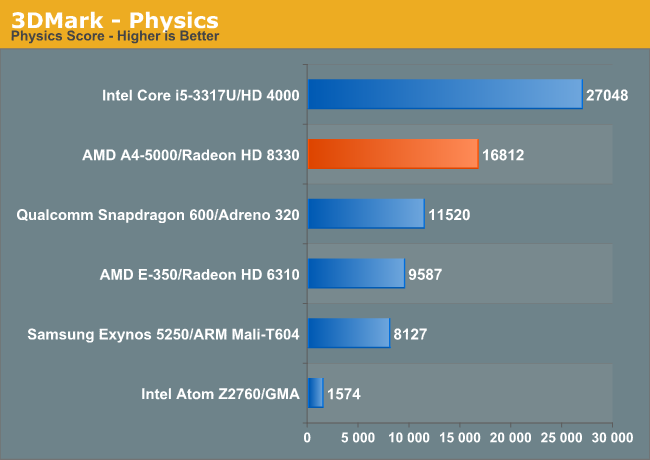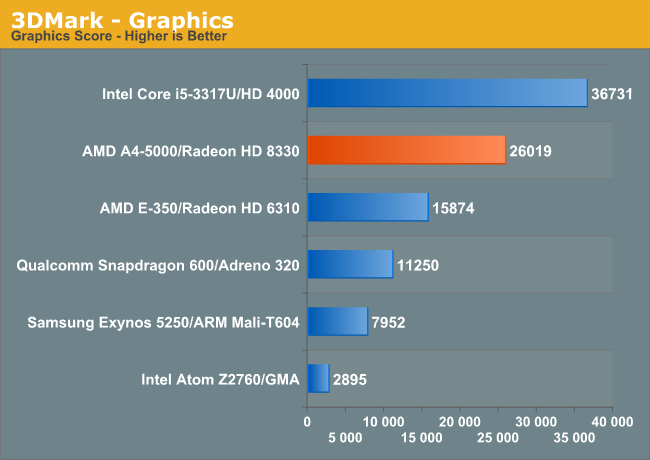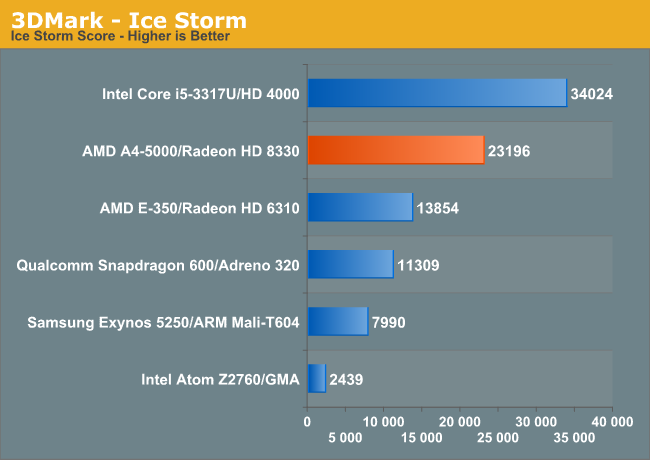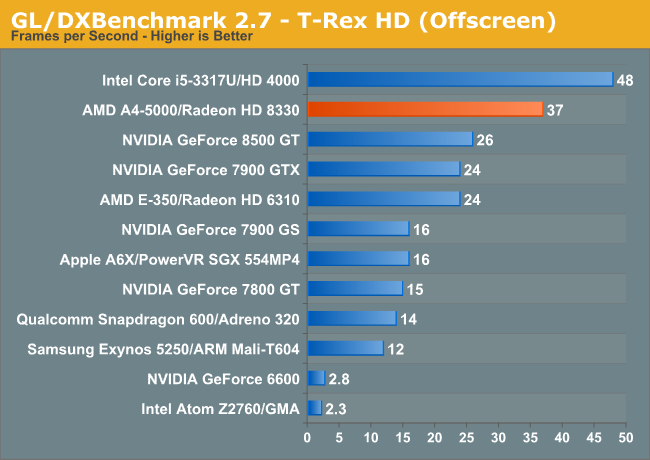The AMD Kabini Review: A4-5000 APU Tested
by Jarred Walton on May 23, 2013 12:00 AM ESTKabini vs CT/ARM: GPU Performance
I pulled out 3DMark and GFXBenchmark (formerly GL/DXBenchmark) for some cross platform GPU comparisons. We'll start with 3DMark Ice Storm and its CPU bound multithreaded physics benchmark:

The physics test is a bit unreasonably multithreaded, which is why we see a 75% uplift compared to AMD's E-350. For FP heavy game physics workloads however, Jaguar does quite well. While a big Ivy Bridge is still going to be quicker, AMD's A4-5000 gets surprisingly close given its much lower cost.
The 3DMark graphics test is more of what we're interested in seeing here. Two GCN compute units (128 SPs/cores) running at 500MHz will really put the old Radeon HD 6310 in Brazos to shame:

The results are quite good. Kabini manages a 61% performance advantage over AMD's old Brazos platform, and actually gets surprisingly close to Intel's HD 4000 in performance. As we discovered earlier, this isn't really enough performance to play modern PC games but casual (and especially tablet) gaming workloads should do wonderfully here.

The overall Ice Storm score just incorporates both physics and graphics test components. As expected, Kabini continues to lead over everything other than the i5-3317U.
Finally we have the GFXBenchmark T-Rex HD test. I threw in a handful of older PC GPUs, although keep in mind that T-Rex HD isn't very memory bandwidth intensive (penalizing some of the old big PC GPUs that had good amounts of memory bandwidth). The test is also better optimized for unified shader architectures, which helps explain the 8500 GT's excellent performance here.

Kabini does very well in this test as well. If we look at the tablet-oriented Temash part (A4-1200) we see that the number of GCN compute units remains unchanged, but max GPU frequency drops to 225MHz from 500MHz. If we assume perfect scaling with GPU clock speed, Temash could offer roughly the same graphics performance as the 4th generation iPad. AMD claims the A4-1200 Temash APU carries a TDP of only 3.9W, a potentially very interesting part from a GPU perspective if our napkin math holds true.
OpenCL Performance
For our last comparison we're looking at the OpenCL performance of these on-die GPUs. We're using a subset of Ryan's GPU Compute workload, partially because many of those tests don't work properly on Kabini yet and also because some of those tests are really built for much more powerful GPUs. We've got LuxMark 2.0 and two CLBenchmark 1.1.3 tests here. Their descriptions follow:
SmallLuxGPU is an OpenCL accelerated ray tracer that is part of the larger LuxRender suite. Ray tracing has become a stronghold for GPUs in recent years as ray tracing maps well to GPU pipelines, allowing artists to render scenes much more quickly than with CPUs alone.
CLBenchmark contains a number of subtests; we’re focusing on the most practical of them, the computer vision test and the fluid simulation test. The former being a useful proxy for computer imaging tasks where systems are required to parse images and identify features (e.g. humans), while fluid simulations are common in professional graphics work and games alike.
| OpenCL GPU Performance | ||||||||||||||||
| LuxMark 2.0 | CLBenchmark—Vision | CLBenchmark—Fluid | ||||||||||||||
| AMD A5-5000 (Radeon HD 8330) | 18K samples/s | 1041 | 1496 | |||||||||||||
| AMD E-350 (Radeon HD 6310) | 23K samples/s | 292 | 505 | |||||||||||||
| Intel Core i5-3317U (HD 4000) | 107K samples/s | 819 | 1383 | |||||||||||||
LuxMark is really a corner case here where Kabini shows a performance regression compared to Brazos. The explanation is simple: some workloads are better suited to AMD's older VLIW GPU architectures. GCN is a scalar architecture that is usually going to net more efficient usage, but every now and then you'll see a slight regression. Intel's HD 4000 actually does amazingly well in the LuxMark 2.0 benchmark.
Our two CLBenchmark tests however paint a very different picture. Here Kabini not only significantly outperforms its predecessor, but is faster than Ivy Bridge as well.










130 Comments
View All Comments
whyso - Thursday, May 23, 2013 - link
Because no one cares about Sandy Bridge ULV considering its now end of life. They also tested a lot of highly synthetic benchmarks. i3 ULV ivy notebooks can be had for $400 on newegg, i5 ULV notebooks cost $500 (http://www.newegg.com/Product/Product.aspx?Item=N8... sale yes but sales happen all the time). Also for the greater part of its lifetime, kabini will compete with haswell.Gaugamela - Thursday, May 23, 2013 - link
No, Kabini will compete with Pentiums. You guys keep forgeting that.And Ivy notebooks will be replaced and Kabini notebooks won't compete with them for most of it's shelf life. As for sales, do you think you won't see sales of Kabini notebooks?
Just because there's a small overlap of vendors clearing up inventory of Ivy notebooks doesn't invalidate that Kabini is a new chip and won't compete with Ivy Bridge for most of its life.
whyso - Thursday, May 23, 2013 - link
No, if an i5 ULV notebook costs $500, an i3 ULV notebook costs $400 and a kabini notebook costs $450 then the kabini is competing with i3/i5 and NOT pentium. Pricewise it competes with i3 and possibly i5. Haswell ULV will launch in a few months. Bobcat launched what? two years ago. With a similar lifetime (hope its shorter) jaguar will be competing with haswell for the vast majority of its lifetime.t.s - Thursday, May 23, 2013 - link
Yep. The barrier IMO, is OEM. OEM tend to hiking the price. When bobcat E350 first out, the average price is ~$360. What the hell. With $460, i can get 2x performance with sandy bridge i3.If only AMD want to build their own machine (laptop and desktop).
Gaugamela - Thursday, May 23, 2013 - link
A Kabini notebook costs 400$. And that's without having into account promotions, which WILL happen just as they happen to those precious i3 Ivy Bridges of yours. You seem to forget that promotions happen to all notebooks. And if you keep bringing ULV i3 Ivy Bridges for that price, then guess what? I'll get a TRINITY APU notebook instead for that price! Because I can also get them!! And they have a much stronger GPU power than Kabini, and Ivy Bridge and I can also get some quite decent ultrathins.whyso - Thursday, May 23, 2013 - link
Trinity and ivy bridge ULV are very similar in gpu performance. ULV ivy demolishes ULV trinity cpu wise though.Gaugamela - Friday, May 24, 2013 - link
The top Trinity LV APU (the A10-4655M) beats the Ivy Bridge ULVs in terms of GPU performance. The issue is that there's barely any notebooks for sale with it (The Samsung Series 5 ultrathin is one, the HP Sleekbook another).The A8-4455M is available in the Asus U38N and a Lenovo model and that one is weak. It's comparable to a Ivy Bridge i3 em terms of CPU/GPU performance (weaker single-thread but better multi-thread - more cores).
However, Trinity powered notebooks are usually cheaper than Ivy Bridge ones and you can get them with great promotions now.
whyso - Friday, May 24, 2013 - link
They are very similar and within error range (+/- around 10%).Gaugamela - Friday, May 24, 2013 - link
No, they're not. A A10-4655M with dual channel RAM beats the living crap of a HD4000. You just don't want to admit that. Go dig for benchmarks before spouting falsehoods.whyso - Friday, May 24, 2013 - link
No, mobile amd apus do very good in 3d mark but poorly in games because games have more cpu load (unlike 3dmark which is very cpu light) and the gpu can't boost as high. For instance the 7660G generally ties with the 630m in 3dmark but loses by about 20% in games. Thats a 25 watt part so it will do better than the 17 watt ULV but beat the living crap? NO. Even the 7660G only beats the HD4000 on average by 30%, move that down to ULV and the difference is less.